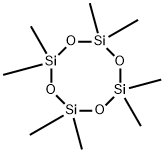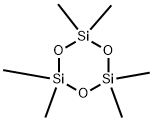Octamethylcyclotetrasiloxane
Synonym(s):Octamethylcyclotetrasiloxane;Octamethyltetrasiloxane
- CAS NO.:556-67-2
- Empirical Formula: C8H24O4Si4
- Molecular Weight: 296.62
- MDL number: MFCD00003269
- EINECS: 209-136-7
- SAFETY DATA SHEET (SDS)
- Update Date: 2025-03-21 19:13:37

What is Octamethylcyclotetrasiloxane?
Description
Octamethylcyclotetrasiloxane is a member of the cyclic siloxane, or cyclomethicone, family. It is often called simply D4 because of its four dimethylsiloxane units. It exists as an oily liquid or low-melting solid.
In 1946, Winton Patnode and Donald F. Wilcock at General Electric (Schenectady, NY) prepared D4 as part of an extensive study of methylpolysiloxanes made by hydrolyzing methylchlorosilanes. In one the many reactions they reported, they mixed dimethyldichlorosilane1 (Me2SiCl2) with large volumes of water to produce a colorless oil with a composition that had an empirical formula close to that of Me2SiO.
Analysis of the oil showed that it was primarily a mixture of cyclic oligomers of the formula (Me2SiO)x, with isolated compounds ranging from x = 3 to x = 10. The relative amounts of each of the cyclosiloxanes varied with hydrolysis conditions such as the Me2SiCl2/H2O ratio and the presence of cosolvents, acids, or bases. In general, D4 (x = 4) was the most abundant product.
Today, D4 is commercially produced by the same general method. The product mixture is separated into its components via distillation. D4 and the other oligomers are used to prepare poly(dimethylsiloxane)2 [(Me2SiO)n], familiarly known as silicone oil. D4 itself is used as an additive to plastic and rubber products, paints, adhesives, cosmetics, food packaging, and many other product areas. Its worldwide production is in the hundreds of thousands of tonnes.
Because of its widespread production and use, D4 has come under scrutiny for its adverse environmental and health effects. Last September, the US Environmental Protection Agency announced an evaluation of the environmental risks of its industrial uses. It will be up to the Food and Drug Administration to determine whether its food, health care, and personal care uses are evaluated.
1. CAS Reg. No. 75-78-5.
2. CAS Reg. No. 9016-00-6.
Chemical properties
Octamethylcyclotetrasiloxane is also known as D4. It is an odorless, colorless non-oily silicone fluid which has C8H24O4Si4 as chemical formula. It is a cyclic organic silicon substance which can be used as monomer in the production of silicone polymers such as rubber, resins and greases.
The Uses of Octamethylcyclotetrasiloxane
Octamethylcyclotetrasiloxane is used as a monomer in the production of silicone polymers and as an intermediate in the production of other organosilicon substances.Further it finds its application in electronics, textiles, personal care products and household care products.
Polydimethylsiloxane by the Polymerization of Octamethylcyclotetrasiloxane: To a resin flask equipped with a thermometer, stirrer, and reflux eondenser is added 1000 gm of octamethylcyclotetrasiloxane. The siloxane is heated to 165°C, and then 0.14gm of a potassium hydroxide-isopropanol complex (neutral equivalent = 193.5) is added to give a Si : Κ ratio of 4470:1. In 25 min the stirrer begins to stall, and the polymer is now heated for 3(1/2) hr at 150°C to complete polymerization. The resulting polymer has an intrinsic viscosity of 1.5 dl/gm corresponding to a molecular weight of 804,600.
Definition
ChEBI: Octamethylcyclotetrasiloxane is a cyclosiloxane that is the octamethyl derivative of cyclotetrasiloxane. It is an organosilicon compound and a cyclosiloxane. It derives from a hydride of a cyclotetrasiloxane.
Preparation
Commercially Octamethylcyclotetrasiloxane is produced from dimethyldichlorosilane. Dimethyldichlorosilane is added dropwise to water, the temperature is maintained at 30-40°C, stratified, the acid water is released, the oily material is hydrolyzed with sodium hydroxide solution, the hydrolysate and 0.5%-2% potassium hydroxide are added to the cracking kettle and cracked at 120-140°C and 99.8 kPa vacuum. The cracked material is fractionated and the fraction is collected at 173-176°C to obtain octamethylcyclotetraoxysilane.
General Description
Octamethylcyclotetrasiloxane (D4) is a volatile methylsiloxane (VMS) with a relatively low molecular weight. This silicone fluid has a silicon-oxygen bond in a cyclic arrangement and methyl groups are attached to the silicon atom. D4 can be used in the manufacture of silicone based polymers for use in medical devices and personal care products.
Health Hazard
Octamethylcyclotetrasiloxane (D4) can interfere with the body’s hormones. In animals, it can affect the reproductive system.
D4 is classified as a category 1 endocrine disruptor by the European Commission. A 2018 study commissioned by the Danish EPA identified D4 as an endocrine disruptor. The Global Harmonized System Label Requirements classified D4 as suspected to produce reproductive toxicity. D4 was added to the Toxic Substances Control Act work plan due to reproductive toxicity, moderate environmental persistence, and high bioaccumulation potential.
Adverse reproductive effects including estrogenic effects have been observed in rodents. The European Chemicals Agency characterized D4 as a persistent, bioaccumulative, and toxic chemical, and designated D4 as a Substance of Very High Concern.
Flammability and Explosibility
Flammable
Safety Profile
A skin irritant. When heated todecomposition it emits acrid smoke and irritating vapors.
Purification Methods
The solid exists in two forms, m 16.30o and 17.65o. Dry it over CaH2 and distil it. Further fractionation can be effected by repeated partial freezing and discarding the liquid phase. [Osthoff & Grubb J Am Chem Soc 76 399 1954, Hoffman J Am Chem Soc 75 6313 1953, Beilstein 4 IV 4125.]
Properties of Octamethylcyclotetrasiloxane
| Melting point: | 17-18 °C (lit.) |
| Boiling point: | 175-176 °C (lit.) |
| Density | 0.956 g/mL at 25 °C (lit.) |
| vapor density | 1 (vs air) |
| vapor pressure | 1.32hPa at 25℃ |
| refractive index | n |
| Flash point: | 140 °F |
| storage temp. | Store below +30°C. |
| solubility | <0.001g/l Hydrolysis |
| form | liquid |
| appearance | colorless oily liquid or white solid |
| color | colorless |
| Specific Gravity | 0.956 |
| explosive limit | 0.4-11.7%(V) |
| Water Solubility | INSOLUBLE |
| Sensitive | Moisture Sensitive |
| Merck | 14,6747 |
| BRN | 1787074 |
| Dielectric constant | 2.4(20℃) |
| CAS DataBase Reference | 556-67-2(CAS DataBase Reference) |
| NIST Chemistry Reference | Cyclotetrasiloxane, octamethyl-(556-67-2) |
| EPA Substance Registry System | Octamethylcyclotetrasiloxane (556-67-2) |
Safety information for Octamethylcyclotetrasiloxane
| Signal word | Warning |
| Pictogram(s) |
 Flame Flammables GHS02  Health Hazard GHS08  Environment GHS09 |
| GHS Hazard Statements |
H226:Flammable liquids H410:Hazardous to the aquatic environment, long-term hazard |
| Precautionary Statement Codes |
P202:Do not handle until all safety precautions have been read and understood. P210:Keep away from heat/sparks/open flames/hot surfaces. — No smoking. P233:Keep container tightly closed. P240:Ground/bond container and receiving equipment. P273:Avoid release to the environment. P308+P313:IF exposed or concerned: Get medical advice/attention. |
Computed Descriptors for Octamethylcyclotetrasiloxane
| InChIKey | HMMGMWAXVFQUOA-UHFFFAOYSA-N |
New Products
Methyl (R)-1-Boc-4,4-difluoropyrrolidine-2-carboxylate 2,2-Difluoropropylamine hydrochloride tert-butyl 3-bromoazetidine-1-carboxylate (R)-1-Boc-3-hydroxypyrrolidine DIFLUOROACETIC ANHYDRIDE 2,2-Difluoropropionic acid Diallylamine, 99% Calcium hydroxide, 95% Aluminum oxide, basic 2-Bromophenylacetonitrile, 97% L-tert-Leucine,97% N-Hydroxy-2-methylpropanimidamide 4-(3,4-Dichlorophenyl)-3,4-Dihydro-N-Methyl-1-(2H)-Naphthalenimine (Schiff Base) 2-AMINO-3,5-DIBROMO BENZALDEHYDE [ADBA] L-Glutamic Acid Dimethyl Ester Hcl 10-Methoxy-5H-dibenz[b,f]azepine 5-Cyanophthalide N, N-Carbonyldiimidazole (CDI) Dibenzoyl Peroxide Titanium Dioxide 2-(Methylthio) Benzonitrile Sodium Acetate Anhydrous Allopurinol 1,5-DibromopentaneRelated products of tetrahydrofuran








You may like
-
 Octamethylcyclotetrasiloxane CAS 556-67-2View Details
Octamethylcyclotetrasiloxane CAS 556-67-2View Details
556-67-2 -
 Octamethylcyclotetrasiloxane 98% CAS 556-67-2View Details
Octamethylcyclotetrasiloxane 98% CAS 556-67-2View Details
556-67-2 -
 Cyclomethicone 4 CAS 556-67-2View Details
Cyclomethicone 4 CAS 556-67-2View Details
556-67-2 -
 Ethyl-2-Chloroacetoacetate 609-15-4View Details
Ethyl-2-Chloroacetoacetate 609-15-4View Details
609-15-4 -
 CIS- BROMO BENZOATEView Details
CIS- BROMO BENZOATEView Details
61397-56-6 -
 609-15-4View Details
609-15-4View Details
609-15-4 -
![1-(6-Methylpyridin-3-Yl)-2-[4-(Methylsulfonyl)Phenyl]Ethanone [Ketosulfone] 99%](https://img.chemicalbook.in//Content/image/CP5.jpg) 1-(6-Methylpyridin-3-Yl)-2-[4-(Methylsulfonyl)Phenyl]Ethanone [Ketosulfone] 99%View Details
1-(6-Methylpyridin-3-Yl)-2-[4-(Methylsulfonyl)Phenyl]Ethanone [Ketosulfone] 99%View Details
221615-75-4 -
 27143-07-3View Details
27143-07-3View Details
27143-07-3
